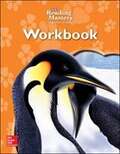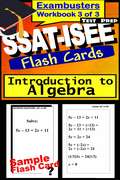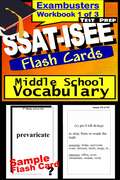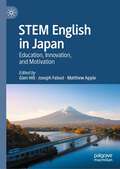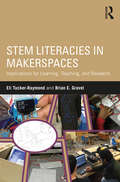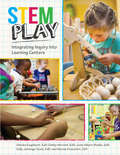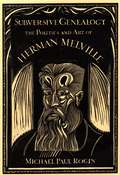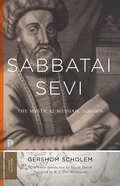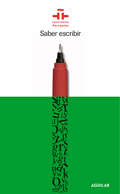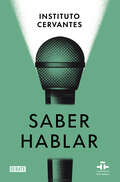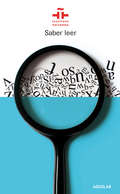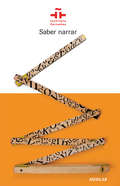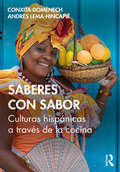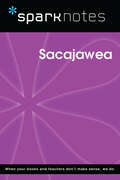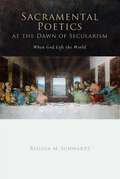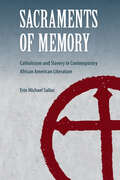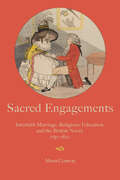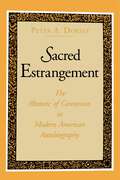- Table View
- List View
SRA: Reading Mastery, Signature Edition, Workbook [Grade 1]
by Siegfried Engelmann Owen Engelmann Karen Lou Seitz DavisNIMAC-sourced textbook
SSAT-ISEE Test Prep Flash Cards: Algebra (Exambusters SSAT-ISEE Workbook #3 of 3)
by Ace Inc.<P><P><i>Advisory: Bookshare has learned that this book offers only partial accessibility. We have kept it in the collection because it is useful for some of our members. Benetech is actively working on projects to improve accessibility issues such as these.</i><P><P> 450 questions and answers that highlight introductory algebra definitions, problems, and concepts. <P><P>Topics: Algebraic Concepts, Sets, Variables, Exponents, Properties of Numbers, Simple Equations, Signed Numbers, Monomials, Polynomials, Additive and Multiplicative Inverse, Word Problems, Prime Numbers, Factoring, Algebraic Fractions, Ratio and Proportion, Variation, Radicals, Quadratic Equations <P>EXAMBUSTERS SSAT and ISEE Prep Workbooks provide comprehensive, fundamental SSAT and ISEE review--one fact at a time--to prepare students to take practice SSAT and ISEE tests. Each SSAT and ISEE study guide focuses on one specific subject area covered on the SSAT and ISEE exams. From 300 to 600 questions and answers, each volume in the SSAT and ISEE series is a quick and easy, focused read. Reviewing SSAT and ISEE flash cards is the first step toward more confident SSAT and ISEE preparation and ultimately, higher SSAT and ISEE exam scores!
SSAT-ISEE Test Prep Flash Cards: Essential Vocabulary (Exambusters SSAT-IEEE Workbook #1 of 3)
by Ace Inc.<P><P><i>Advisory: Bookshare has learned that this book offers only partial accessibility. We have kept it in the collection because it is useful for some of our members. Benetech is actively working on projects to improve accessibility issues such as these.</i><P><P> "SSAT-ISEE Prep Flashcard Workbook 1: MIDDLE SCHOOL VOCABULARY-Review" 300 basic words every high school freshman should know. Includes part of speech, pronunciation, succinct, easy-to-remember definition, and common synonyms and antonyms. <P>EXAMBUSTERS SSAT and ISEE Prep Workbooks provide comprehensive, fundamental SSAT and ISEE review--one fact at a time--to prepare students to take practice SSAT and ISEE tests. Each SSAT and ISEE study guide focuses on one specific subject area covered on the SSAT and ISEE exams. From 300 to 600 questions and answers, each volume in the SSAT and ISEE series is a quick and easy, focused read. Reviewing SSAT and ISEE flash cards is the first step toward more confident SSAT and ISEE preparation and ultimately, higher SSAT and ISEE exam scores!
STAAR Master Student Practice Book: Reading Grade 3
by ECS Learning SystemsA Puzzling Gift, Part of the Family, The Ungrateful Tiger, A Super Example,Woolly Bear Forecasters, Black Jack, Dear Abigail, Say Cheese, Weird, Wiggly, and Wonderful, The ""Helping Basket, Artist of Mystery, Junkyard Art, Topper's First Day of School, So Many Ways to Say Hello, Babe, Big Time, Tailspin, The Fieldmouse,
STEM English in Japan: Education, Innovation, and Motivation
by Glen Hill Joseph Falout Matthew AppleThis book focuses on Japanese science, technology, engineering and mathematics (STEM) students and their experiences of learning English. Students majoring in STEM face unique circumstances regarding their English language education. Despite the global use of English in these fields, the authors argue that Japanese STEM students fail to take advantage of coursework, extracurricular materials, teachers, peers, and other resources to raise their communicative abilities to a sufficient level for the workplace. This book offers insights into how STEM students can learn English more effectively and purposefully. The chapters provide firsthand perspectives into the psychologies, educational programs, and future workplace situations of Japanese STEM students, who are the innovators, inventors, and researchers of the future. This book will appeal to applied linguists and language teachers wherever STEM English is taught.
STEM Literacies in Makerspaces: Implications for Learning, Teaching, and Research
by Eli Tucker-Raymond Brian E. GravelProviding an original framework for the study of makerspaces in a literacy context, this book bridges the scholarship of literacy studies and STEM and offers a window into the practices that makers learn and interact with. Tucker-Raymond and Gravel define and illustrate five key STEM literacies—identifying, organizing, and integrating information; creating and traversing representations; communicating with others for help and feedback during making; documenting processes; and communicating finished products—and demonstrate how these literacies intersect with making communities. Through careful observation and analysis of multiple case studies, the authors highlight the impact of research and practice to support teaching and making in a variety of environments. Using a nuanced, engaging framework, they examine the necessary skills required to develop and foster makerspaces in formal and informal contexts for all students. Grounded in cutting-edge research, this volume paves the way for future study on supporting making and literacies in STEM.
STEM Play: Integrating Inquiry into Learning Centers
by Deirdre Englehart Debby Mitchell Junie Albers-Biddle Kelly Jennings-Towle Marnie ForestieriMost early childhood teachers are using learning centers in the classroom, but do not approach them in ways that fully support a variety of learning opportunities. This book approaches learning centers through the STEM (science, technology, engineering, math) lens, and shares how themes can be integrated into centers to promote creativity and higher-level thinking. STEM Play provides varied activities for the most common centers: Art, blocks, dramatic play, literacy, math, science, music and movement. Full of beautiful, full-color photos that show the activities in real early childhood classrooms, teachers can easily use the book’s ideas immediately in their curriculum. STEM Play also includes a “How To” section for teachers who wish to expand on the STEM focus and use themed activities in their learning centers.
STEM to Story
by 826 NationalBring STEM to life for students with zombies, rockets, celebrities, and moreSTEM to Story: Enthralling and Effective Lesson Plans for Grades 5-8 inspires learning through fun, engaging, and meaningful lesson plans that fuse hands-on discovery in science, technology, engineering, and math (STEM) with creative writing. The workshop activities within the book are the innovative result of a partnership between 826 National's proven creative writing model and Time Warner Cable's Connect a Million Minds, an initiative dedicated to connecting young people to the wonders of STEM through hands-on learning. Authentically aligned with both the Common Core State Standards and the Next Generation Science Standards, this book provides teachers, after-school and out-of-school providers, and parents with field-tested lessons, workshops, and projects designed by professionals in each field. Including reflective observations by arts and science celebrities like Jon Scieszka, Mayim Bialik, and Steve Hockensmith, lessons feature bonus activities, fun facts, and teaching points for instructors at every level. These quirky, exploratory lessons will effectively awaken student imaginations and passions for both STEM and creative writing, encourage identity with scientific endeavors, and make both science and writing fun.Grades five through eight is the critical period for engaging students in STEM, and this book is designed specifically to appeal to - and engage - this age group. The guided curricula fosters hands-on discovery, deep learning, and rich inquiry skills while feeling more like play than school, and has proven popular and effective with both students and teachers.Awaken student imagination and get them excited about STEMFuse creative writing with STEM using hands-on activitiesMake scientific principles relevant to students' livesInspire students to explore STEM topics furtherThe demand for STEM workers is closely linked to global competitiveness, and a successful future in STEM depends upon an early introduction to the scientific mindset. The challenge for teachers is to break through students' preconceptions of STEM fields as "hard" or "boring," to show them that STEM is everywhere, it's relevant, and it's loads of fun. For proven lesson plans with just a dash of weird, STEM to Story is a dynamic resource, adaptable and applicable in school, after school, and at home.
STEMscopes™ Texas: Science Literacy, [Grade] 3, English
by Inc. Accelerate Learning Rice UniversityNIMAC-sourced textbook
STEMscopes™ Texas: Science Literacy, [Grade] 4, English
by Inc. Accelerate Learning Rice UniversityNIMAC-sourced textbook
SUBVERSIVE GENEALOGY
by Michael Paul RoginIn this major reconsideration of Herman Melville's life and work, Michael Paul Rogin shows that Melville's novels are connected both to the important issues of his time and to the exploits of his patrician and politically prominent family--which, three generations after its Revolutionary War heroes, produced an alcoholic, a bankrupt, and a suicide. Rogin argues that a history of Melville's fiction, and of the society represented in it, is also a history of the writer's family. He describes how that family first engaged Melville in and then isolated him from American political and social life. Melville's brother and father-in-law are shown to link Moby-Dick to the crisis over expansion and slavery. White-Jacket and Billy Budd, which concern shipboard conflicts between masters and seamen, are related to an execution at sea in which Melville's cousin played a decisive part. The figure of Melville's father haunts The Confidence Man, whose subject is the triumph of the marketplace and the absence of authority. A provocative study of one of our supreme literary artists.
Sabbatai Ṣevi: The Mystical Messiah, 1626-1676
by Gershom Scholem Yaacob Dweck R. J. WerblowskyGershom Scholem stands out among modern thinkers for the richness and power of his historical imagination. A work widely esteemed as his magnum opus, Sabbatai Ṣevi offers a vividly detailed account of the only messianic movement ever to engulf the entire Jewish world. Sabbatai Ṣevi was an obscure kabbalist rabbi of seventeenth-century Turkey who aroused a fervent following that spread over the Jewish world after he declared himself to be the Messiah. The movement suffered a severe blow when Ṣevi was forced to convert to Islam, but a clandestine sect survived. A monumental and revisionary work of Jewish historiography, Sabbatai Ṣevi details Ṣevi's rise to prominence and stands out for its combination of philological and empirical authority and passion. This edition contains a new introduction by Yaacob Dweck that explains the scholarly importance of Scholem's work to a new generation of readers.
Saber escribir
by Instituto CervantesLas pautas que necesitas para aprender a escribir mejor. Saber escribir expone con claridad, amenidad y rigor las pautas necesarias para escribir lo que pensamos y decimos. ¿Sabe escribir un informe, una carta, el acta de una reunión o un proyecto? ¿Sabe cómo tomar apuntes, contestar a una pregunta de examen o preparar su currículum? ¿Sabe redactar una carta de reclamación, presentar una instancia, dirigirse a la Administración o componer una invitación? Saber escribir no es un manual de estilo o de corrección gramatical ni un diccionario de dudas; no es un manual de creación literaria, aunque enseñe técnicas y recursos de escritura que aparecen en los textos literarios. Es todo lo anterior, y más. Es otro concepto de manual. Es un instrumento imprescindible para los que dudan, para los que tienen pánico a la página o a la pantalla en blanco, para los que tienen necesidad de escribir, en definitiva. Saber escribir expone con claridad, amenidad y rigor las pautas necesarias para escribir lo que pensamos y decimos. Nace con la intención de ayudar a redactar; de ampliar los procedimientos de generación y precisión de ideas, de documentación y de planificación; de seleccionar los elementos de unión adecuados; de relacionar de forma conveniente el contenido del tema con la expresión, el registro y el estilo elegidos, y de aprender a aplicar las técnicas de revisión y corrección para lograr la redacción y la disposición exigidas en cualquier presentación escrita.
Saber hablar
by Instituto CervantesSaber hablar explica con claridad, amenidad y rigor las pautas necesarias para expresar lo que pensamos; facilita la comunicación entre los seres; amplía los procedimientos de generación y precisión de ideas, de documentación y de planificación. Vivimos rodeados de palabras, inmersos en un tráfico constante de expresiones en un mundo que es diálogo por naturaleza. ¿Alguna vez se ha parado a pensar en el poder que le confiere el habla? Un buen discurso es la clave del éxito. Saber hablar reivindica el arte de la comunicación oral, motor de las relaciones interpersonales, sociales, económicas y profesionales, en un tiempo donde impera el dominio del verbo. Hoy más que nunca saber hablar bien es una necesidad. Este libro ofrece la posibilidad de emplear el habla de manera adecuada según el momento y la situación, que pueden ser formales -la consulta del médico, el rectorado de la universidad, una entrevista de trabajo, una junta de vecinos, una exposición comercial- o coloquiales -la familia o los amigos-.
Saber hablar
by Instituto Cervantes Marta Albelda Marco Salvador Pons BorderíaNueva edición revisada y actualizada de un clásico español sobre la comunicación oral Vivimos rodeados de palabras, inmersos en un tráfico constante de expresiones que se producen en un mundo que es diálogo por naturaleza. Sin embargo, pocas veces nos detenemos a pensar en el poder que nos confiere el habla. Un buen discurso es la clave del éxito. Saber hablar es, desde su primera publicación en 2008, un referente entre los libros sobre comunicación oral, concebida esta como motor de las relaciones interpersonales, sociales, económicas y profesionales, en un tiempo en el que impera el dominio de la palabra. Este libro, que ahora se presenta en una edición revisada, actualizada y ampliada, ofrece la posibilidad de emplear el habla de manera adecuada según el momento y la situación, ya sea esta formal -la consulta del médico, el rectorado de una universidad, una entrevista de trabajo, una junta de vecinos, una exposición comercial- o coloquial -un encuentro con la familia o los amigos-, y según se utilice en un ámbito reducido o público y por canales presenciales o virtuales, tan extendidos en los últimos tiempos. Saber hablar explica con claridad, amenidad y rigor las pautas necesarias para expresar lo que pensamos; facilita la comunicación entre las personas, y da pautas para enriquecer los procedimientos de generación de ideas y para expresarlas con una mayor precisión y riqueza.
Saber leer
by Instituto CervantesSaber leer se ha convertido en una habilidad imprescindible. Los formatos digitales traen consigo modos de lectura diferentes y desafían al lector a participar en nuevas estrategias en las que es protagonista. La educación recibida y la gran cantidad de comunicaciones escritas que se obtienen a diario en una sociedad globalizada no garantizan que los lectores sean capaces de interpretar los escritos de forma correcta. En su caso ¿está seguro de entender bien lo que lee? ¿Es capaz de recordar lo que ha leído y contarlo con otras palabras? ¿Podría sintetizar los puntos más importantes de un texto? Saber leer completa la trilogía iniciada con Saber escribir y Saber hablar: una obra divulgativa que se dirige a un público amplio, a personas interesadas en los procesos, en la comprensión y en el aprendizaje de la lectura. Gracias a ella aprenderemos las estrategias necesarias para enfrentarnos a todo tipo de textos, cómo desarrollar un pensamiento crítico a través de la lectura y la relación de ésta con la escritura, los procesos de comunicación, el aprendizaje y la memoria. Descubra en estas páginas cómo leer líneas y entrelíneas.
Saber narrar
by Instituto CervantesDescubra en estas páginas el arte de la narración periodística, literaria y cinematográfica. Saber comunicar captando la atención de un receptor es imprescindible en una sociedad como la nuestra en la que los medios de comunicación protagonizan nuestras vidas. Además, con los formatos digitales es habitual tener que enfrentarse a la temida hoja en blanco. ¿Cómo ordenamos lo que queremos decir? ¿Qué elementos debo introducir en el texto para que suscite el interés del lector? Si estoy en una reunión, ¿sabré expresar las ideas de un modo ordenado? Saber contar se ha convertido en una destreza imprescindible hoy día. Y hay tres ámbitos fundamentales para comunicarse: narrativa, periodismo y cine. Tres expertos en cada una de estas tres facetas nos darán las claves para poder empezar a narrar en clave periodística, en clave literaria y en clave cinematográfica. Saber narrar completa la colección iniciada con Saberescribir, Saber hablar y Saber leer. Una obra divulgativa que se dirige a un público amplio, a personas interesadas en los procesos narrativos y en el aprendizaje de los diferentes modos de expresión. Gracias a ella y de la mano de los expertos aprenderemos las estrategias necesarias para generar todo tipo de textos, y suscitar el interés por lo que se quiere contar, dentro de los procesos de comunicación, el aprendizaje y la memoria.
Saberes con sabor: Culturas hispánicas a través de la cocina
by Andrés Lema-Hincapié Conxita DomènechSaberes con sabor: Culturas hispánicas a través de la cocina es un manual avanzado que responde al creciente interés por el estudio de las prácticas culinarias y alimenticias de Ibero-América, sin desatender ni la lengua ni la cultura de esas regiones del mundo. Cada capítulo comprende aspectos vinculados con recetas, lengua, arte y teoría. Los estudiantes son expuestos a temas de geografía, historia, literatura, política, economía, religión, música e, incluso, cuestiones de género que estarían implicadas en la elaboración y en el consumo de ciertas comidas. Y, esto, mientras mejoran sus habilidades en temas esenciales y específicos del español. A lo largo del libro, están incorporados materiales de internet —como vínculos para videos, registros sonoros, referencias históricas, sitios web de cocina y contenidos suplementarios para la investigación. Muy útil en cursos universitarios, Saberes con sabor es un recurso original y único de aprendizaje para estudiantes fascinados por los placeres del paladar y, de igual manera, con una genuina pasión por las culturas hispánicas.
Sabotage in the Sky
by L. Ron HubbardLaunch into the action with this triumphant tale! Pilot Terry Lee has taught Bill Trevillian everything he knows about flying, enough that Bill's know considered the ace of American test pilots just as war breaks out in World War II Europe. Unknown to Bill, Terry's also taught his own kid sister, Kip, who's now almost as good a pilot as Bill and quite the looker to boot. When France and Great Britain must choose between different American plane designs to outfly the newest and deadliest Nazi fighters, the competing companies send their two best test pilots . . . Kip and Bill. Unfortunately, a spy also has been sent to infiltrate and sabotage the planes to make sure that neither the French nor British will consider them safe enough to fly. Soon Kip and Bill suspect the other of sabotage-- a problem that not only threatens their already electric relationship but their very lives. "Riveting cliff-hanger action." --Midwest Book Review
Sacajawea (SparkNotes Biography Guide)
by SparkNotesSacajawea (SparkNotes Biography Guide) Making the reading experience fun! SparkNotes Biography Guides examine the lives of historical luminaries, from Alexander the Great to Virginia Woolf. Each biography guide includes:An examination of the historical context in which the person lived A summary of the person&’s life and achievements A glossary of important terms, people, and events An in-depth look at the key epochs in the person&’s career Study questions and essay topics A review test Suggestions for further reading Whether you&’re a student of history or just a student cramming for a history exam, SparkNotes Biography guides are a reliable, thorough, and readable resource.
Sacramental Poetics at the Dawn of Secularism
by Regina SchwartzSacramental Poetics at the Dawn of Secularism asks what happened when the world was shaken by challenges to the sacred order as people had known it, an order that regulated both their actions and beliefs. When Reformers gave up the doctrine of transubstantiation (even as they held onto revised forms of the Eucharist), they lost a doctrine that infuses all materiality, spirituality, and signification with the presence of God. That presence guaranteed the cleansing of human fault, the establishment of justice, the success of communication, the possibility of union with God and another, and love. These longings were not lost but displaced, Schwartz argues, onto other cultural forms in a movement from ritual to the arts, from the sacrament to the sacramental. Investigating the relationship of the arts to the sacred, Schwartz returns to the primary meaning of "sacramental" as "sign making," noting that because the sign always points beyond itself, it participates in transcendence, and this evocation of transcendence, of mystery, is the work of a sacramental poetics.
Sacraments of Memory: Catholicism and Slavery in Contemporary African American Literature
by Erin Michael SaliusCatholic themes and imagery in the work of writers including Toni Morrison, Leon Forrest, Phyllis Alesia Perry, and Charles Johnson Sacraments of Memory is the first book to focus on Catholic themes and imagery in African American literature. Erin Michael Salius discovers striking elements of the religion in neo-slave narratives written by Toni Morrison, Leon Forrest, Phyllis Alesia Perry, and Charles Johnson, among others. Examining the emergence of this major literary genre following Vatican II and amidst the Black Power and civil rights movements, she uncovers the presence of Catholic rituals and mysteries—including references to the Eucharist, Augustinian theology, spirit possession, and stigmata. These textual references occur alongside and in tension with criticisms of the Church's political and social policies. Salius offers a nuanced reading of Beloved that interprets the novel in light of Toni Morrison's affiliation with the religion. She argues that Morrison, and the other novelists in this study, draw on a Catholic countertradition in American literature that resists Enlightenment rationality. She highlights allusions to Catholic tropes such as the connections between spirit possession and the hijacking of Jane's narrative voice in Ernest Gaines's The Autobiography of Miss Jane Pittman. Salius also identifies Augustinian theology on the prescience of God in the flash-forward narrative techniques used in Edward P. Jones's The Known World. These authors use Catholicism to challenge the historical realism of past slave autobiographies and the conventional story of American slavery. Ultimately, Salius contends that this tradition enables these novelists to imagine and express radically different ways of remembering the past. Publication of the paperback edition made possible by a Sustaining the Humanities through the American Rescue Plan grant from the National Endowment for the Humanities.
Sacred Engagements: Interfaith Marriage, Religious Toleration, and the British Novel, 1750–1820
by Alison ConwayA revelatory reading of the British novel that considers interfaith marriage, religious toleration, and the ethics of sociability.Bringing together feminist theory, novel criticism, and religious studies, Alison Conway's Sacred Engagements advances a postsecular reading of the novel that links religious tolerance and the eighteenth-century marriage plot. Conway explores the historical roots of the vexed questions that interfaith marriage continues to raise today. She argues that narrative wields the power to imagine conjugal and religious relations that support the embodied politics crucial to a communal, rather than state-sponsored, ethics of toleration.Conway studies the communal and gendered aspects of religious experience embedded in Samuel Richardson's account of interfaith marriage and liberalism's understandings of toleration in Sir Charles Grandison. In her readings of Frances Brooke, Elizabeth Inchbald, and Maria Edgeworth, Conway considers how women authors reframe the questions posed by Grandison, representing intimacy, authorship, and women's religious subjectivity in ways that challenge the social and political norms of Protestant British culture. She concludes with reflections on Jane Austen's Mansfield Park and the costs of a marriage plot that insists on religious conformity. By examining the complex epistemologies of the interfaith marriage plot, Sacred Engagements counters the secularization thesis that has long dominated eighteenth-century novel studies. In so doing, the book recognizes those subjects otherwise ignored by liberal political theory and extrapolates how a genuinely inclusive tolerance might be imagined in our own deeply divided times.
Sacred Estrangement: The Rhetoric of Conversion in Modern American Autobiography
by Peter A. DorseySacred Estrangement analyzes certain works by important American writers and thinkers in the context of the "rhetoric of conversion." Such analysis is especially valuable because it provides a reliable index of the relationship between the self and larger communities. Traditionally, "conversion" has served a socializing function, signifying that one has come into alignment with certain linguistic, behavioral, and cultural expectations. The socialization process is particularly apparent in the Christian conversion narratives of the seventeenth through nineteenth centuries: by publicly testifying to a conversion experience, believers became empowered members, not only of God's elect community but also of a local population. As modern autobiography developed in the eighteenth and nineteenth centuries, the Christian pattern was secularized and individualized. Conversion became a model for many kinds of psychological change. With the coming of the twentieth century, however, the authors upon whom Peter Dorsey focuses, including William and Henry James, Henry Adams, Edith Wharton, Ellen Glasgow, Zora Neale Hurston, and Richard Wright, radically revised conversion rhetoric. If conversion had traditionally linked the search for illumination with the search for a defined social role, these writers increasingly used conversion as an index of estrangement from mainstream America. Dorsey documents this profound change in the way American intellectuals defined the "self," not in terms of personal orientation toward or away from a given community, but as a resistance to such an orientation altogether, as if social forces by their "nature" were a threat to personal identity.
Sacred Estrangement: The Rhetoric of Conversion in Modern American Autobiography (G - Reference, Information and Interdisciplinary Subjects)
by Peter A. DorseySacred Estrangement analyzes certain works by important American writers and thinkers in the context of the "rhetoric of conversion." Such analysis is especially valuable because it provides a reliable index of the relationship between the self and larger communities. Traditionally, "conversion" has served a socializing function, signifying that one has come into alignment with certain linguistic, behavioral, and cultural expectations. The socialization process is particularly apparent in the Christian conversion narratives of the seventeenth through nineteenth centuries: by publicly testifying to a conversion experience, believers became empowered members, not only of God's elect community but also of a local population. As modern autobiography developed in the eighteenth and nineteenth centuries, the Christian pattern was secularized and individualized. Conversion became a model for many kinds of psychological change. With the coming of the twentieth century, however, the authors upon whom Peter Dorsey focuses, including William and Henry James, Henry Adams, Edith Wharton, Ellen Glasgow, Zora Neale Hurston, and Richard Wright, radically revised conversion rhetoric. If conversion had traditionally linked the search for illumination with the search for a defined social role, these writers increasingly used conversion as an index of estrangement from mainstream America. Dorsey documents this profound change in the way American intellectuals defined the "self," not in terms of personal orientation toward or away from a given community, but as a resistance to such an orientation altogether, as if social forces by their "nature" were a threat to personal identity.
